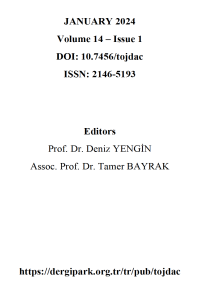INSTRUMENT MAKING IN CONCEPTUAL ART PARADIGM AND TRANSFORMATIVE PROJECTIONS OF SOUND SCULPTURE CONCEPT AS A REFLECTİON OF POSTMODERN SOUND DESIGN FIELDS
Öz
Individuals who derive notions such as art, craft, and design through the act of making artworks have discovered the design possibilities of the audio context, as in different disciplines focusing on these concepts, and have experienced many in-depth forms of reception about life through various practices. This process has blurred the boundaries between the plastic and visual arts and rendered their elements transitive, particularly since the last quarter of the 19th Century, with projections ranging from music/sound production to the tools they will use to perform them—from the architecture of the spaces where they are performed, to the technologies to capture these performances. The Futurists’ frequently exemplified productions associated with speed, time, and sound were reinforced and documented, especially with Russolo’s Intonarumori and The Art of Noise manifesto, as some of the earliest examples of artistic sound studies. Likewise, Duchamp’s Dadaist works, such as Sculpture Musicale and With Hidden Noise at the beginning of the 20th century, were pioneering in defining fields such as Sound Objects, Sound Sculpture, and Sound Art. In the middle of the same century, in parallel to socioeconomic developments, the definition and limitations of artistic sound studies expanded further through new technologies and conceptual backgrounds. After World War II, significant transformations took place in music and sound practices, as in many other fields, and the conceptual dimensions of these fields were opened to discussion. Especially after the 1960s, with the influence of Postmodernism, the concept of sound gained new dimensions and propositions regarding transformations with new production and material technologies experienced. In this article, using qualitative research methods, the development of the Sound Sculpture genre, which started with bare experimentations and progressed in tandem with the fields of instrument design and evolved into an independent production area under the realms of audial design over time, is reviewed and examined through its position in the 20th and 21st-century contemporary art movements, its conceptual background, and basic propositions. Sound Sculpture, an experimental and conceptual instrument-making field parallel to traditional instrument-making practices, is presented as well as an alternative proposal in this study.
Anahtar Kelimeler
Sound Sculpture Sound Design Instrument Design Conceptualism
KAVRAMSAL SANAT PARADİGMASINDA ENSTRÜMAN YAPIMI VE POSTMODERN DUYSAL TASARIM ALANLARINA BİR YANSIMASI OLARAK SOUND SCULPTURE KAVRAMININ DÖNÜŞTÜRÜCÜ İZDÜŞÜMLERİ
Öz
Yapıt kurma edimi üzerinden sanat, zanaat ve tasarım gibi nosyonları türeten bireyler, bu kavramları merkezlerine alan farklı disiplinlerde olduğu gibi duysal bağlamın tasarı olanaklarını da keşfetmiş ve çeşitli uygulamalar üzerinden hayata dair nice derinlikli alımlama biçimleri deneyimlemişlerdir. Bu süreç, müzik/ses üretiminden bunları gerçekleştirecekleri araçlara; müziği icra edecekleri mekânların mimarisinden, bu performansları kayıt altına alacakları teknolojilere kadar izdüşümleriyle, özellikle 19. Yüzyılın son çeyreğinden itibaren, geniş bir alana yayılan duysal tasarım çalışmalarının plastik ve görsel sanatlarla sınırlarını muğlaklaştırmış, öğelerini geçişkenleştirmiştir. Fütüristlerin sıkça örneklenen; hız, zaman ve sesle ilişkilendirdikleri üretimleri, özellikle Russolo’nun Intonarumori’leriyle, sanatsal ses/enstrüman çalışmalarının erkence örneklerinden birini verdiği, The Art of Noise manifestosuyla pekiştirilmiş ve belgeleştirilmiştir. Keza, Duchamp’ın 20. Yüzyılın başında Sculpture Musicale, With Hidden Noise gibi Dadacı çalışmaları Sound Object, Sound Sculpture, Sound Art gibi alanların tanımlanması bakımından öncü niteliktedir. Aynı yüzyılın ortalarındaysa sosyoekonomik gelişmelere koşut, yeni teknolojiler ve kavramsal arka plan üzerinden sanatsal ses çalışmalarının tanımı ve sınırları daha da genişlemiştir. II. Dünya Savaşı sonrasında birçok alanda olduğu gibi müzik ve ses pratiklerinde de önemli dönüşümler gerçekleşmiş; bu alanların kavramsal boyutları tartışmaya açılmıştır. Özellikle 1960’lardan sonra Postmodernizmin de etkisiyle sound kavramı, yeni üretim ve malzeme teknolojileriyle dönüşümler deneyimleyen enstrüman tasarım alanlarıyla yepyeni boyutlar kazanmış, peşi sıra yeni önermelerine kavuşmuştur. Nitel araştırma yöntemleri kullanılarak hazırlanan bu derleme makalede; deneysellikle başlayan enstrüman tasarım alanlarıyla içli dışlı ve birbirlerine koşut ilerleyen, zamanla duysal tasarım alanının müstakil bir üretim alanına evirilen, Sound Sculpture türünün gelişimi; 20. ve 21. Yüzyıl çağdaş sanat akımları içerisindeki konumu, kavramsal arka planı, başat önermeleri üzerinden incelenmektedir. Bu çalışmada aynı zamanda gelenekselleşen enstrüman yapım pratiklerine koşut, deneysel ve kavramsal bir enstrüman yapım alanı olan Sound Sculpture türü alternatif bir öneri olarak sunulmaktadır.
Anahtar Kelimeler
Ses Heykelleri Duysal Tasarım Enstrüman Tasarım Kavramsallık
Ayrıntılar
| Birincil Dil | Türkçe |
|---|---|
| Konular | Disiplinlerarası Sanat |
| Bölüm | SANAT VE EDEBİYAT |
| Yazarlar | |
| Erken Görünüm Tarihi | 15 Aralık 2023 |
| Yayımlanma Tarihi | 28 Aralık 2023 |
| Gönderilme Tarihi | 25 Ekim 2023 |
| Kabul Tarihi | 8 Aralık 2023 |
| Yayımlandığı Sayı | Yıl 2024 Cilt: 14 Sayı: 1 |
Kaynak Göster
Cited By
21. YÜZYIL ENSTRÜMAN TASARIM VE YAPIM PRATİKLERİNDE YENİ BİR YAKLAŞIM ÖNERİSİ; HİBRİT LUTİYELİK
Online Journal of Music Sciences
https://doi.org/10.31811/ojomus.1435966
All site content, except where otherwise noted, is licensed under a Creative Common Attribution Licence. (CC-BY-NC 4.0)



